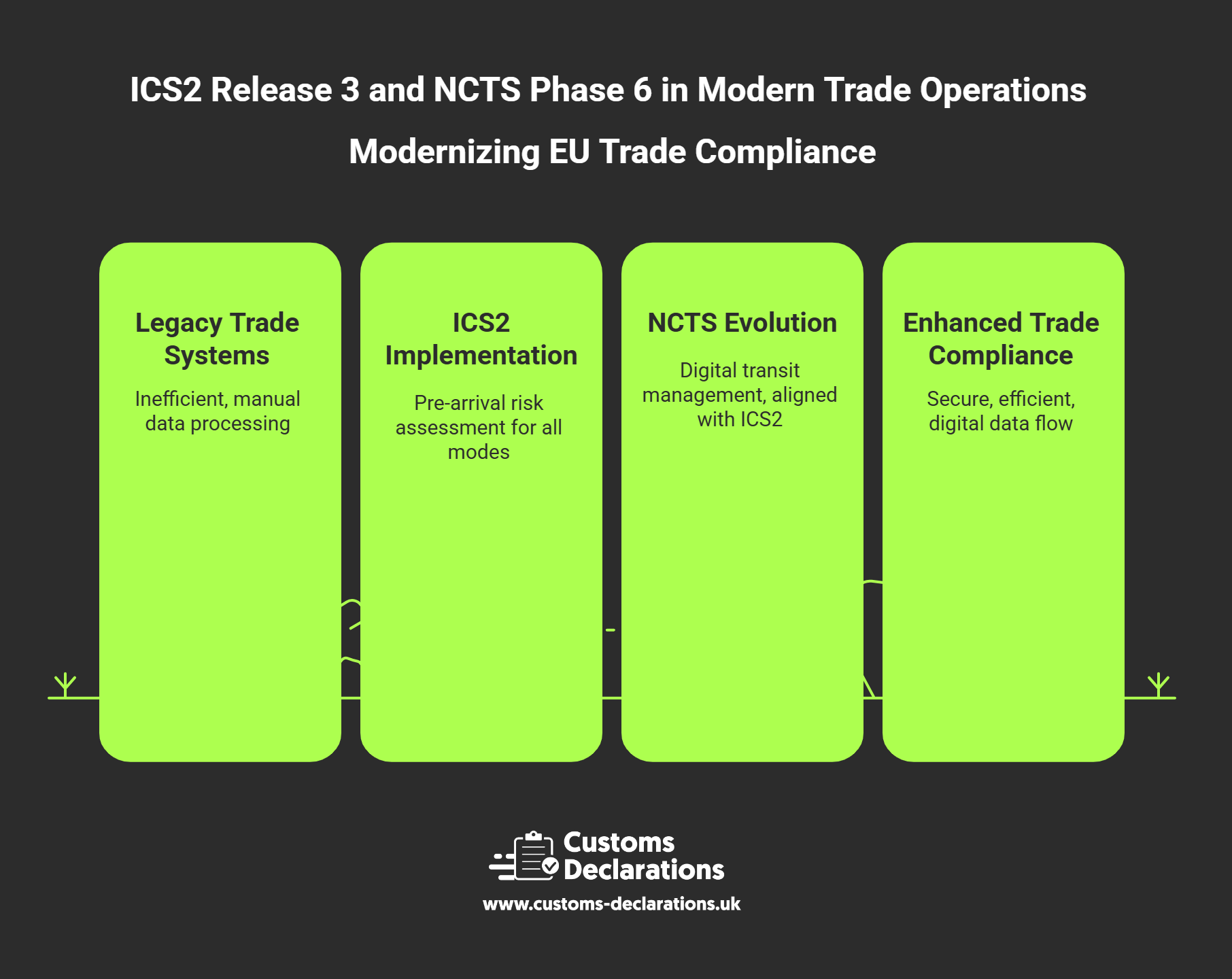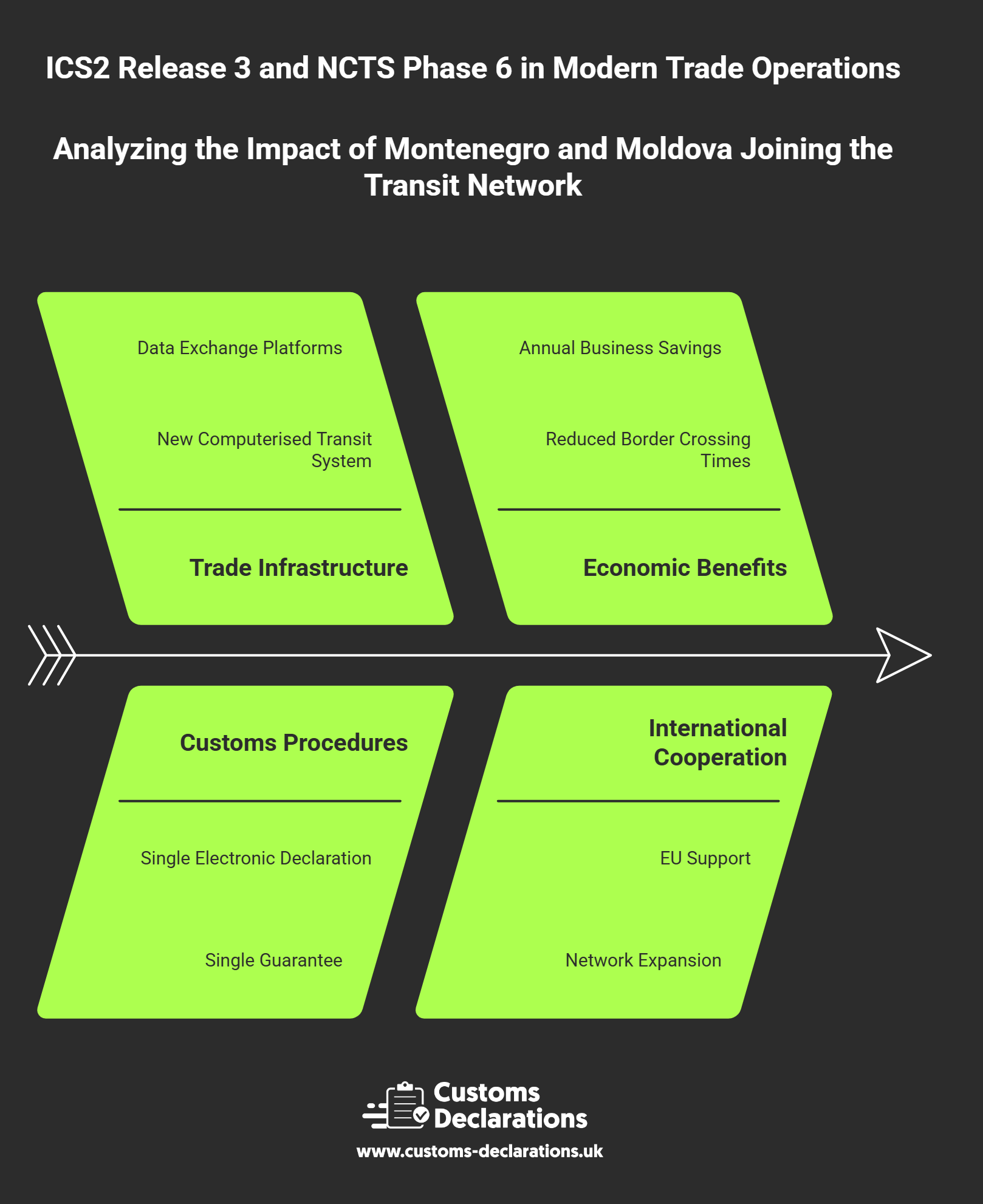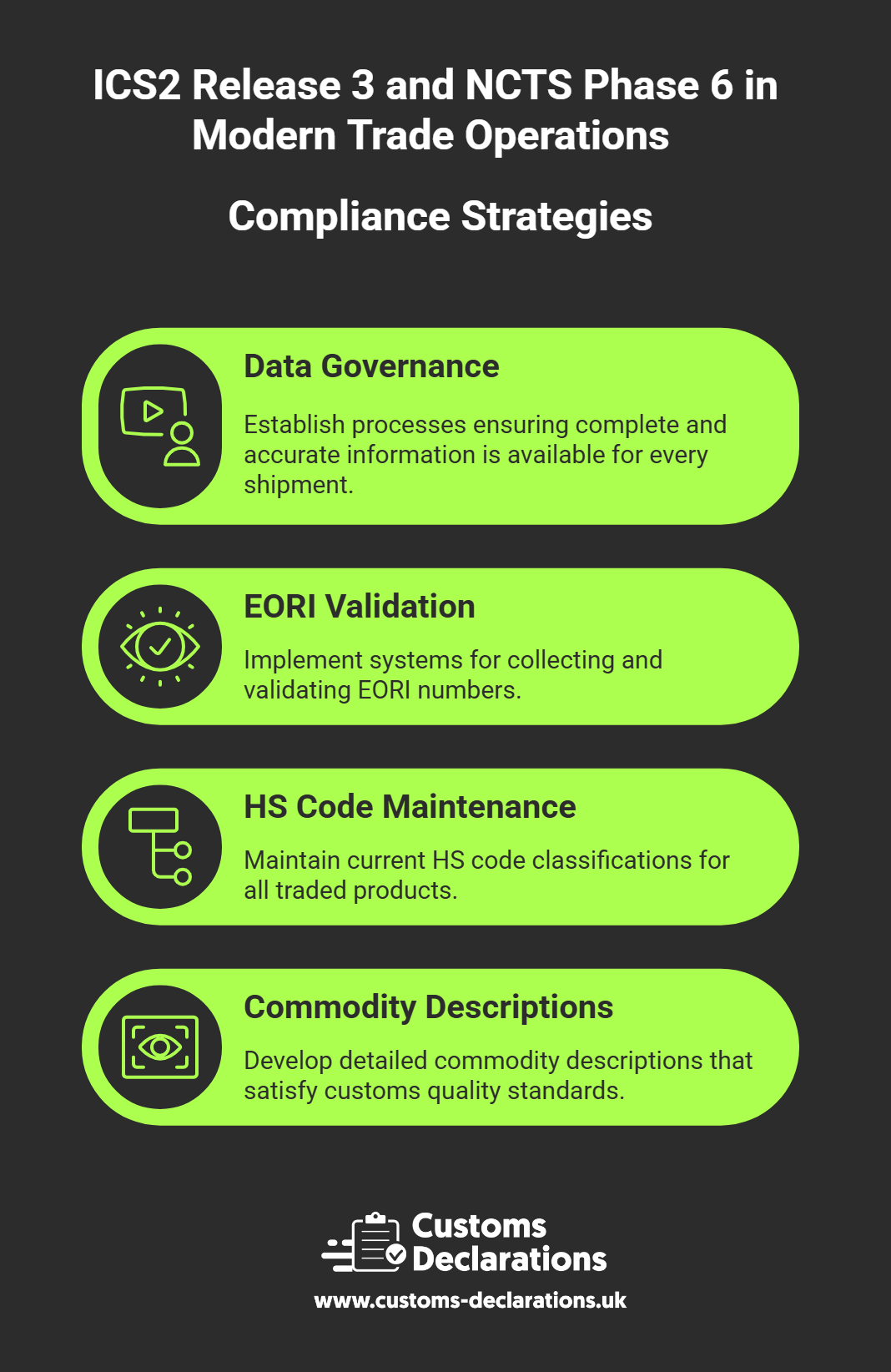The European customs landscape is undergoing its most significant transformation in decades, driven by the parallel evolution of two critical systems: the Import Control System 2 (ICS2) and the New Computerised Transit System Phase 6 (NCTS-P6). These developments, culminating in late 2025, represent a fundamental shift in how goods move across European borders, affecting traders, carriers, and customs authorities throughout the European Union, EFTA nations, and Common Transit Convention member states. This comprehensive analysis examines the strategic implications of these changes and provides practical guidance for businesses navigating this new regulatory environment.
Understanding the Foundation: ICS2 and NCTS Systems
The Import Control System 2 represents the European Union’s advanced cargo information framework, designed to enhance safety and security through comprehensive pre-arrival risk assessment. ICS2 now manages safety and security data for all incoming goods across air, maritime, road, and rail transport, with ICS1 being entirely phased out as of September 1, 2025. This system enables customs authorities to conduct sophisticated risk analysis before goods physically arrive at EU borders, fundamentally changing the compliance landscape for international trade.
The New Computerised Transit System serves a complementary but distinct function, managing the movement of goods under transit procedures across multiple customs territories. NCTS facilitates the electronic processing of transit declarations, issues unique transit identifiers through Movement Reference Numbers, and provides digital Transit Accompanying Documents for transport operators. The system has evolved through multiple phases, with Phase 6 representing the latest iteration designed to align with ICS2’s enhanced security requirements.
The deployment window for NCTS Phase 6 started on March 1, 2025, and ended on September 1, 2025, though several member states requested temporary extensions to implementation deadlines. This staggered rollout reflects the complexity of coordinating technical upgrades across numerous national customs administrations while maintaining operational continuity for thousands of economic operators.
ICS2 Release 3: Expanding Security Coverage to Ground Transportation
The third release of ICS2 marked a watershed moment in European customs security by extending comprehensive Entry Summary Declaration requirements to road and rail transport. From April 1, 2025, road and rail carriers began providing data on goods sent to or through the EU prior to their arrival through a complete ENS, with this obligation also affecting postal and express carriers using these transport modes. This expansion completed ICS2’s coverage across all transportation modes, creating a unified security framework for cargo entering or transiting European territories.
The data quality requirements under ICS2 Release 3 have become substantially more rigorous. Economic operators must now provide complete commercial descriptions of goods, avoiding generic terms that customs authorities classify as “stop words.” These prohibited terms include vague descriptors such as “various,” “parts,” or “miscellaneous,” which provide insufficient information for effective risk assessment. The European Commission maintains a comprehensive list of these restricted terms through the CIRCABC document-sharing platform, along with detailed guidance on acceptable data quality standards.
ICS2 allows different parties in the supply chain to each submit portions of the ENS, with freight forwarders filing house-level data while carriers provide transport-level data, with this multiple filing approach becoming fully available by the end of 2025. This distributed filing capability recognizes the complex nature of modern supply chains, where multiple actors may hold different pieces of information about a single shipment. However, it also creates new coordination challenges, as parties must ensure their respective submissions align and collectively satisfy all regulatory requirements.
The mandatory data elements for ENS submissions have expanded significantly. Beyond basic commodity information, filers must now provide Economic Operator Registration and Identification numbers for both consignors and consignees, full names and addresses for all parties involved, buyer and seller details when these differ from consignors and consignees, and harmonized system codes to at least six digits. This granular data enables customs authorities to conduct sophisticated risk profiling and targeted interventions before goods physically arrive.
NCTS Phase 6: Separating Transit and Security Functions
The sixth phase of the New Computerised Transit System introduces fundamental changes to how transit and security data interact within the European customs framework. Norway implemented NCTS Phase 6 on November 26, 2025, choosing to become an “opt-out” country where transit declarations combined with Entry Summary Declaration data are no longer accepted, requiring separate submissions in NCTS and ICS2 respectively. This decision reflects a broader strategic choice facing all Common Transit Convention members: whether to maintain integrated filing capabilities or mandate separate submissions for transit and security purposes.
Countries selecting the opt-in approach for NCTS Phase 6 allow economic operators to continue submitting combined transit declarations containing safety and security data through a single system. This approach reduces administrative burden for traders but requires more complex technical infrastructure from customs authorities. Conversely, opt-out countries like Norway require distinct submissions: transit data through NCTS and security information through ICS2. Norway’s decision to opt out was primarily driven by the desire to reduce implementation risks and costs, noting minimal demand from traders to send transit declarations combined with ENS data upon import.
The technical architecture of NCTS Phase 6 introduces three new message types for communication between customs administrations: IE119 for rejection at frontier crossings, IE117 for presentation notifications at transit offices, and IE058 for rejections from transit offices. However, national implementation varies, with some countries like Norway choosing not to implement certain messages for external communication with declarants. This selective adoption allows customs authorities to balance functionality with implementation complexity.
Despite these changes, NCTS Phase 6 remains fundamentally compatible with its predecessor. NCTS Phase 6 builds upon the technical platform developed for NCTS Phase 5, representing a minor upgrade with the most significant change being that certain countries will no longer accept transit declarations combined with security data. This continuity minimizes disruption for software providers and economic operators who have already invested in Phase 5 compatibility.
Geographic Expansion: Montenegro and Moldova Join the Transit Network
November 2025 witnessed a significant geographic expansion of the Common Transit Convention network. On November 1, 2025, Moldova and Montenegro became the latest countries to join the Common Transit Convention and the Convention on the Simplification of Formalities in Trade in Goods, joining a network that facilitates movement of goods between the EU, EFTA countries, Turkey, North Macedonia, Serbia, the United Kingdom, Georgia, and Ukraine. This expansion represents unprecedented growth for the transit framework, with 2025 marking the addition of three new members following Georgia’s accession in February.
For Moldova, membership in the Common Transit Convention represents a transformative development for its trade infrastructure. The country’s customs service successfully implemented the New Computerised Transit System with support from a European Union grant, connecting its national electronic system to trans-European data exchange platforms. The transit procedure allows Moldova to conduct operations by submitting a single electronic transit declaration at the place of departure and a single guarantee, without repeated customs formalities at each border, with the declaration remaining valid until reaching the destination within contracting parties to the convention. Moldovan customs authorities estimate this will reduce border crossing times by thirty to forty percent and generate annual business savings of up to five million euros.
Montenegro’s accession reinforces the Western Balkans’ integration into European trade networks. As the latest Western Balkan state to join these conventions, Montenegro strengthens regional customs harmonization and facilitates more efficient movement of goods across traditionally congested land borders. The timing of these accessions aligns strategically with the broader implementation of NCTS Phase 6, enabling these new members to join with the most current technical standards rather than requiring subsequent upgrades.
Strategic Implications for UK-EU Trade Relations
The convergence of ICS2 and NCTS Phase 6 creates particular implications for trade between the United Kingdom and European Union. Following the UK’s departure from the EU, goods moving between these territories fall under international trade procedures requiring comprehensive customs declarations. The enhanced data requirements of ICS2 Release 3 add new layers of complexity to these movements, particularly for road freight which represents a substantial portion of UK-EU trade volume.
Recent guidance from logistics providers highlights the heightened compliance expectations. Carriers moving goods from the UK to the EU must file Entry Summary Declarations at least one hour before arrival, with this requirement becoming strictly enforced from January 2026. The quality standards for these submissions have intensified, with customs systems automatically rejecting declarations containing insufficient commodity descriptions or missing mandatory data elements. Non-compliance can result in cargo being held at borders, delayed entry, financial penalties, and in severe cases, refusal of goods entry entirely.
For businesses engaged in UK-EU trade, these requirements necessitate substantial operational adjustments. Companies must establish robust data collection processes ensuring they can gather complete information for every shipment: full party details including EORI numbers, precise commodity descriptions with six-digit HS codes, and comprehensive documentation supporting the declared goods. The one-hour filing deadline before arrival requires careful coordination of supply chain timing, as late submissions can trigger automatic risk assessments and potential cargo holds.
Navigating Temporary Derogations and Implementation Timelines
The rollout of ICS2 Release 3 and NCTS Phase 6 has not followed a uniform timeline across all European territories. Several EU Member States and the United Kingdom in respect of Northern Ireland requested temporary extensions to implementation deadlines, with these derogations easing the transition for economic operators, especially small enterprises adapting to new rules. Some member states obtained permission to continue accepting security data combined with transit declarations via NCTS Phase 5 during transitional periods.
Derogation decisions to provide ENS data either in NCTS Phase 6 or in ICS2 for road and rail traffic may be granted by the European Commission with retroactive effect from September 1, 2025, until December 31, 2025 for goods entering through certain countries, with some member states receiving extensions until June 1, 2026. These graduated timelines reflect recognition that smaller operators and certain member states required additional preparation time to meet the technical and operational demands of the new systems.
Economic operators must carefully track which countries have opted for derogations and the specific timelines applicable to their trade routes. A shipment transiting through multiple jurisdictions may encounter different requirements depending on entry points and transit countries. Some nations mandate ICS2 submissions from September 2025, while others permit continued use of older systems or combined filings through specified transition periods. This patchwork of implementation dates requires sophisticated compliance management to ensure adherence across varied regulatory environments.
Filing Customs Declarations Through Customs Declarations UK
For businesses seeking streamlined compliance with these evolving European customs requirements, specialized platforms offer comprehensive solutions for managing complex declaration processes. Customs Declarations UK will provide an integrated approach to filing customs declarations, covering the Customs Declaration Service, Import Control System 2, and New Computerised Transit System requirements through a single unified interface.
The platform will addresses the core challenges businesses face under the new regulatory framework: managing detailed data requirements, meeting strict submission deadlines, and coordinating between different customs systems. Through Customs Declarations UK, economic operators would be able to submit Entry Summary Declarations for ICS2 compliance, file transit declarations for NCTS procedures, and manage comprehensive customs declarations for import and export operations. The system incorporates validation logic ensuring submissions meet current data quality standards, automatically flagging potential issues before declarations reach customs authorities.
Practical Compliance Strategies for Economic Operators
Successfully navigating the transformed European customs environment requires proactive adaptation across multiple operational dimensions. Economic operators should prioritize comprehensive data governance, establishing processes ensuring complete and accurate information is available for every shipment before goods begin their journey. This includes implementing systems for collecting and validating EORI numbers, maintaining current HS code classifications for all traded products, and developing detailed commodity descriptions that satisfy customs quality standards while avoiding prohibited “stop words.”
Investment in appropriate technology infrastructure represents another critical success factor. Companies relying on manual processes or outdated systems face substantial compliance risks under ICS2 and NCTS Phase 6. Modern declaration platforms offering automated validation, real-time status tracking, and integration with existing enterprise systems provide essential capabilities for managing the increased complexity and accelerated timelines of current requirements. Organizations should evaluate whether to develop internal capabilities or partner with specialized IT service providers offering proven customs compliance solutions.
Staff training and supply chain partner coordination merit equal attention. All parties involved in cross-border movements must understand current requirements, filing deadlines, and consequences of non-compliance. For complex shipments involving multiple actors, clear agreements defining responsibility for specific declaration components help prevent gaps where each party assumes another will handle particular obligations. Regular communication with logistics providers, freight forwarders, and customs brokers ensures aligned understanding of evolving requirements and expedites resolution of any issues arising during transit.
Businesses should also actively monitor regulatory developments affecting their specific trade routes. Following official communications from customs authorities in relevant jurisdictions, participating in industry working groups, and maintaining relationships with customs professionals provide early awareness of upcoming changes. This forward-looking approach enables proactive adjustment rather than reactive scrambling when new requirements take effect, reducing business disruption and compliance risks.
Future Trajectory: Beyond 2025 Implementation
While 2025 represents a pivotal year for European customs transformation, the evolution of ICS2 and NCTS continues beyond current implementation milestones. The European Commission has indicated ongoing refinement of both systems based on operational experience and changing security requirements. Multiple filing capabilities under ICS2 will continue expanding, with enhanced coordination mechanisms between different supply chain parties to ensure complete and consistent data submissions.
Technical specifications for both systems will likely undergo further updates as authorities identify opportunities for improvement and address implementation challenges discovered during initial deployment. Economic operators should anticipate additional guidance documents, updated message formats, and refined data quality requirements emerging over subsequent years. Maintaining flexibility in compliance infrastructure will prove valuable as these refinements continue.
The geographic scope of the Common Transit Convention may expand further, with additional countries in the Western Balkans and Eastern Partnership regions expressing interest in membership. Each new accession broadens the seamless transit area, potentially opening new trade routes and market opportunities for businesses prepared to leverage these expanded networks. However, new members also introduce additional complexity in terms of varying implementation timelines and technical capabilities requiring consideration in route planning and compliance strategies.
Conclusion
The convergence of ICS2 Release 3 and NCTS Phase 6 implementation in 2025 marks a fundamental restructuring of European customs operations, driven by imperatives for enhanced security, improved efficiency, and expanded digital capabilities. These changes create both challenges and opportunities for businesses engaged in cross-border trade within and through European territories. Success in this transformed environment requires comprehensive understanding of new requirements, investment in appropriate compliance infrastructure, and proactive adaptation of operational processes.
For economic operators, the path forward involves balancing increased administrative demands with the benefits of more predictable customs processing, reduced physical inspections for compliant shipments, and access to expanded transit networks through new Common Transit Convention members. Organizations that embrace these changes, implement robust compliance frameworks, and leverage specialized platforms like Customs Declarations UK will position themselves advantageously in an increasingly digital and interconnected European trade environment. As systems continue maturing and stabilizing beyond initial implementation phases, early adopters of best practices will realize competitive advantages through smoother border crossings, reduced delays, and enhanced supply chain reliability.




